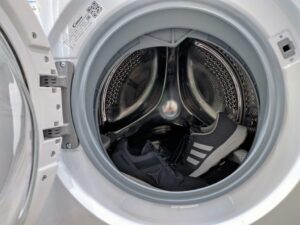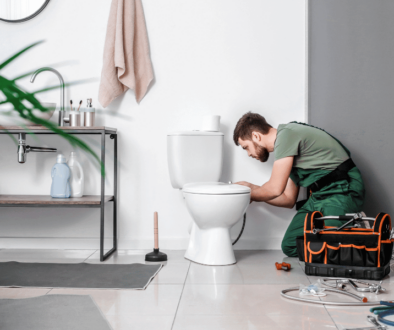Tips to Avoid Washing Machine Plumbing Problems
Having a washing machine in your home is convenient and time-saving. Most of us wouldn’t dream of living without one. But, as with any machine, there’s a network of plumbing tucked away inside it that can cause problems if not managed correctly.
In this article, we’ll take a spin at your washing machine’s plumbing system, teaching you how to dodge any ensuing issues and extend its service life. We’ll discuss the key components of washing machine plumbing, common problems, and preventive measures to ensure smooth operation. We also throw in some do-it-yourself troubleshooting tips for minor plumbing issues that most homeowners can handle.
Understanding Washing Machine Plumbing
It’s important to have a basic understanding of washing machine plumbing before we delve into the preventive measures and quick fixes. Washing machine plumbing involves a series of components that collaborate to guarantee smooth water inflow, proper drainage, and efficient functioning.
Let’s take a closer look at the basic components of washing machine plumbing:
Water Supply Hoses
Water supply hoses are an essential part of washing machine plumbing and a common culprit of washing machine snafus. These hoses deliver water to the washing machine and are usually made of durable materials like rubber or stainless steel to withstand strong water pressure. These hoses are connected to a water supply valve, allowing you to control the water flow. Check water supply hoses regularly for signs of wear or leaks.
Drain Hose
The drain hose plays a crucial role in washing machine plumbing. It carries the used water out and into the household drainage system. This hose is typically made of flexible material, allowing it to be easily connected to the washing machine and the drain pipe. Make sure the drain hose is tightly secured to prevent any leaks or blockages that could lead to water damage or drainage issues.
The Washing Machine
The washing machine itself is the central component of the plumbing system. Ingeniously designed, it houses all the mechanisms to facilitate the washing and spinning cycles.
When you first take a look inside the machine, you’ll see the drum. This part holds the clothes and rotates during the washing process. The drum is equipped with paddles or agitators that help to move the clothes around and ensure thorough cleaning for each item. Lastly, washing machines are equipped with various sensors and controls that regulate water temperature, cycle duration, and other settings to create optimal washing results.
How Washing Machine Plumbing Works
Now that we’ve got a handle on the basic components, let’s take a closer look at how washing machine plumbing works:
When you start a washing cycle, the water supply valves open, allowing water to flow into the machine. The water is then mixed with detergent and fabric softener, if desired, to create a soapy solution that will effectively clean the clothes. The washing machine’s motor and agitators work together to move the clothes around in the drum, ensuring that every garment is thoroughly cleaned.
Once the washing is complete, the drain hose directs the used water out of the machine and into the drainage system. This ensures that the dirty water is properly disposed of and does not contaminate the clean clothes. If connected properly and free from blockages, the drain hose will keep water flowing smoothly out of the washer free of blockages and leaks.
Next comes the spinning cycle. This cycle removes excess water from the clothes by rapidly rotating the drum. The centrifugal force created by the spinning action pushes the water out of the clothes and towards the edges of the drum. The water is then drained through the drain hose, leaving the clothes damp and ready for drying.
By knowing your machine inside out, you’ll be in a great position to carry out efficient maintenance and troubleshooting. This helps to prolong its lifespan and avoid calls to the repairmen.
Common Washing Machine Plumbing Problems
Despite their durability, washing machines do experience plumbing problems from time to time. We encourage customers to familiarize themselves with their machines, identify issues early, and take appropriate measures to fix them.
Now we’ll move on to common washing machine plumbing issues. These are the problems that customers call us for most often.
Drainage Issues
Drainage issues occur if the drain hose becomes clogged with lint, debris, or other foreign objects. A clogged drain hose causes water to back up into the machine, resulting in inefficient washing or even flooding.
To prevent drainage issues, inspect and clean the drain hose regularly. Remove any built-up lint or debris and use a lint trap or filter to help catch lint before it reaches the drain hose.
Leaks and Overflows
Leaks can occur due to loose connections or damaged hoses. Overflows can be caused by a malfunctioning water level sensor or an obstruction in the drainage system.
If your machine is leaking, check all connections and tighten them if necessary. Damaged hoses should be replaced ASAP to prevent further leaks and potential water damage in your laundry room. For overflows, the water level sensor should be checked (by you or a professional if you don’t know how). Also, clear any obvious obstructions and built-up residue.
Hose Problems
Hoses are like ticking time bombs, susceptible to wear, tear, cracks, and eventually, bursting, causing leaks and water damage. Hence, the importance of frequently inspecting and substituting these hoses cannot be overstated.
As you conduct these routine inspections, keep an eye out for any telltale red flags like visible cracks, bulges, or signs of fraying. The moment you spot one or more of these, replace the hose without delay. And here’s a pro tip: opt for stainless steel braided hoses if possible. They carry a reputation for being significantly more durable and less susceptible to damage.
By addressing these common washing machine plumbing problems head-on, you can ensure the longevity and efficiency of your appliance. Regular maintenance, inspections, and swift repairs are key to preventing larger and costlier issues down the line. Your wallet will thank you!
Preventive Measures for Plumbing Problems
Avoid washing machine plumbing problems with these preventive measures:
Regular Maintenance and Inspection
Regular maintenance and inspection can help detect any potential issues before they escalate. Check the hoses for signs of wear and tear and make sure they’re tightly connected. Don’t forget to clean out any debris from the filter or drain hose regularly.
In addition to checking the hoses, it’s equally important to clean out any debris from the filter or drain hose regularly. Over time, lint, hair, and other particles can accumulate in these areas, causing blockages and hindering proper drainage.
By keeping an eye on hoses and connections, you can identify any small leaks or cracks before they turn into full-blown flooding. This early detection will pay for itself ten times over – large washing machine leaks are a plumbing nightmare and can cause thousands of dollars of water damage.
Proper Use of Detergents and Fabric Softeners
When it comes to using detergents and fabric softeners, less is often more. Using too much detergent and fabric softener can result in the buildup of residue, which can clog the drain hose and cause drainage issues. Follow the manufacturer’s instructions for the correct amount of detergent and fabric softener to use for each load. Eco-friendly and low-sudsing detergents can also reduce the risk of clogs and drainage issues.
Correct Loading of the Washing Machine
Stuffing your washing machine to the brim may seem like a harmless and efficient time-saver. On the contrary, overloading the washing machine can put excessive strain on the plumbing system, leading to leaks and other problems. Make sure to distribute the clothes evenly and respect the machine’s load limit.
It can be tempting to cram as many clothes as possible into a single load to save time and energy. Don’t fall for this line of thinking.
When you overload the machine, it struggles to agitate and rinse the clothes effectively. This can result in poor cleaning performance and the need for additional cycles, wasting water and energy. Heavier loads also amplify movement within the machine, applying extra strain on hoses and connections. This increased pressure elevates the risk of leaks and other unwelcome plumbing problems.
To prevent these issues, distribute the clothes evenly in the machine and avoid overfilling it beyond its capacity. Sticking to the manufacturer-specified load size guidelines will ensure that your washing machine runs smoothly, and your plumbing system stays free from unnecessary stress.
Catch up on our latest posts:
Troubleshooting Minor Washing Machine Plumbing Issues
A few minor washing machine issues can be solved by homeowners themselves. This is why it’s so important to understand how the machine works. Let’s take a look:
Dealing with Blocked Drains
Drainage issues are usually due to a blocked drain hose. Common culprits include lint, debris, or even small articles of clothing. To address this issue, start by carefully disconnecting the drain hose from the machine. Take a close look at the hose and check for any clogs or obstructions. If you spot any debris, remove it carefully, doing your best not to push it further into the hose. Once the hose is clear, reconnect it securely to the washing machine. If this doesn’t resolve the drainage problem, it’s time for more diagnostics.
To prevent blockages in the first place, consider adding a lint trap to your washing machine’s drain hose to catch any lint or debris before it enters the plumbing system. Avoid overloading the machine, as it increases the likelihood of clogs.
Fixing Leaky Hoses
If there’s a leak in one of your machine’s hoses, fast action is crucial to protect your home from water damage. First things first, switch off the water supply to the machine to curtail any flood-like situation. Once the water supply is off, carefully disconnect the leaking hose from both the washing machine and the water source. Inspect the hose for any cracks, holes, or signs of damage.
If the hose is damaged beyond repair, it’s best to replace it with a new one. As you install the new hose, ensure that the connection is snug to prevent any further leaks. Finally, turn on the water supply and check for any leaks. If everything looks good, you can start using your washing machine again without worrying about water damage.
Remember to regularly inspect hoses connected to your washing machine for any signs of wear and tear. Over time, hoses can become brittle and develop cracks, which is why leaks happen. Proactively replacing worn-out hoses can nip many problems in the bud and keep your laundry room dry and safe.
Addressing Overflows
In the unfortunate event of an overflow, you’ll have to act fast to prevent water damage and further plumbing issues. Do the following steps quickly and while you wait for a professional to arrive.
Start by turning off the machine to stop the flow of water and prevent any additional flooding. Next, inspect the drainage system for any clogs or obstructions. This includes the drain hose, the drain pipe, or even the drain itself. If you can identify a blockage, try to clear it using a plumbing snake or a wire coat hanger. Be careful not to push the blockage further into the plumbing system.
If you can’t clear the blockage and don’t know how to proceed, call a professional for assistance. Time is of the essence, and a plumber will have the tools and expertise to address the issue quickly and without damaging your home further.
Key Takeaways
By following these tips to avoid washing machine plumbing problems, you can enjoy hassle-free laundry days and extend the lifespan of your washing machine. Remember:
- Clean lint traps and inspect hoses for wear and tear often.
- Use detergents and fabric softeners as recommended by the manufacturer – avoid using more than directed.
- Never overload the machine or place the clothes all on one side.
Addressing minor plumbing issues will keep problems at bay and your washing machine lasting for years to come.



